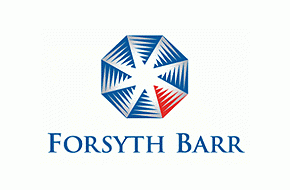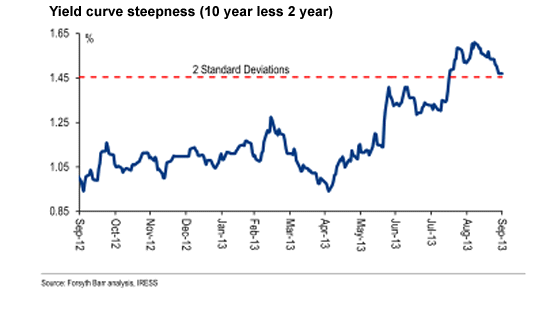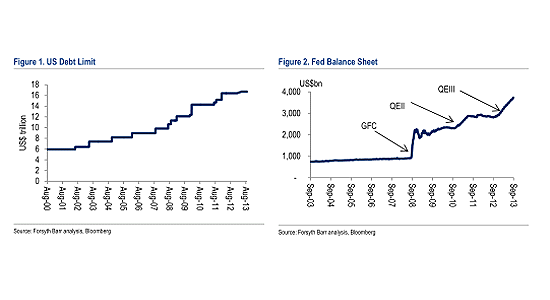
Content supplied by Forsyth Barr
The following is a summary of the key events impacting fixed income markets over the past week.
The Reserve Bank of New Zealand (RBNZ) reiterated its challenges in managing monetary policy with an over-valued New Zealand dollar and a debt fuelled housing market.
RBNZ’s annual report
The Governor of the RBNZ, Graeme Wheeler, has continued his fight against the strong NZD and the over-valued housing market in the RBNZ’s annual report. In terms of the housing market, the RBNZ’s radical loan-to-value restrictions kick-in from 1 October and are already having an impact.
ASB must have borrowed Fonterra’s PR company and decided to announce a 4 October deadline for all of its outstanding pre-approval loans that have less than 20% equity. This announcement drew sharp criticism from Finance Minister Bill English and no doubt harsher words from some customers.
There is more house price data due next Monday but it is likely that it would be a few months before we can assess if the macro-prudential tool is working. If it is, then it is possible the RBNZ has gained some breathing space in terms of raising the Official Cash Rate. Dealing with the overvalued NZD is more problematic given the US Federal Reserve’s continuation of its bond buying programme. The NZD is not the only currency around the world that is being impacted by the Fed’s monetary policy.
The week that was
The yield on the US 10-year continued its recent rally, falling -8bp over the week and is now -38bp lower than its recent highs of 3.01% on 6 September. As yet, there has been very little reaction from the US bond market to the debt ceiling saga that has reignited.
Locally we have seen a flattening of the yield curve at the long-end of the curve (10-year swap) has fallen ~20bp over the last 10 days, whilst the 2-year is -11bp lower. The steepness of the yield curve is now 1.46%, -15bp flatter than three weeks ago when it peaked at 1.61%.

The yield on the ANZ Investment Grade Bond Index is also lower, falling -5bp over the week and is now, at 4.86%, -16bp lower than its recent highs on 13 September.
Key US employment data this week
The closely watched US non-farm payrolls data is released on Friday night, in what will once again be a highly anticipated release. Forecasts are for no change to the 7.3% unemployment rate, despite the creation of an expected 180,000 jobs in August.
At present the US debt ceiling is taking centre stage (see over page), however the market fully expects a decision to be made. US Treasury Secretary Jacob Lew has (for the first time) actually placed a specific date of 17 October before the US would be down to their last US$30bn.
The bond market and rating agencies are yet to react, with the rating agencies not only wanting to see a conclusion but also a credible plan going forward. Band-Aid’s all round!
US debt limit saga returns
Like a bad sequel to a horror movie, the US debt ceiling saga returns to the headlines. Washington is in the process of ‘negotiating’ where the latest is a proposal to delay the Obamacare health-care law by one year.
However, there appears to be a real possibility of a partial government shut-down for the first time in 17 years if an agreement cannot be reached before 1 October. A federal shut-down is not new and has occurred 17 times since 1976. The longest closure was 21 days in 1995-1996.
An important thing to note is that a shut-down is NOT classified as a default. A government shut-down is different to that of a breach of the debt ceiling.
If there is a shut-down then up to two-thirds of government employees can be sent home with “essential personnel” still reporting to work. There is however some breathing room for the government which has a cash cushion which could see it last to late October.
The market appears reasonably relaxed that a deal will get done, however if this saga returns for a re-run in a month’s time, then it may be a different story. History suggests that a political party that is blamed for a shut-down often pays a hefty price.
Market implications can be severe as witnessed in November 2011 when dithering politicians lead to a sovereign credit rating downgrade and a large sell-off in the share-market. The S&P500 fell nearly 20% as a result.
A Band-Aid solution is the most likely and expected outcome after some gesturing and posturing by politicians who need to be seen and heard.
Ratings agency Moody’s seem unperturbed by the latest debt ceiling dithering, stating, “We expect the US will both avoid a shutdown and increase the debt limit; failure at either would have negative economic consequences. A failure to raise the federal debt limit, however, would have greater adverse financial market and economic consequences because market participants would perceive an increased probability of sovereign default.”
Debt levels getting ridiculous!
In the aftermath of the Global Financial Crisis (GFC) which ironically was caused by too much debt, the Fed and the US as a nation just continues to mount up the debt. The Fed’s open ended monetary policy that sees it purchase US$85bn worth of securities per month has seen its balance sheet balloon +33% over the last year.

Corporate / Credit news
APN News & Media (APN) is moving along in its sale process of brandsExclusive. APN signalled in its half year result that it would look to divest the online business saying it isn’t a natural owner of the business. APN purchased brandsExclusive last June for A$36m under its previous management.
Christchurch International Airport (CIA) issued NZ$50m of eight year senior bonds at a margin of 1.475%. The coupon was set at the minimum of 6.25%. Fonterra released its FY13 financial results which signalled a tough FY14 coming up. EBIT fell -3% versus the pcp however reported NPAT rose +18% to NZ$718m.
Fonterra was forced to pay farmers earlier than expected and therefore operating cashflow fell sharply from NZ$1,015m to NZ$689m. This impacted on net debt which increased by +6% to NZ$4,616m as at 31 July 2013. Fonterra’s gearing increased to 39.4% (FY12 37.4%) with interest cover (net debt/EBITDA) rising from 2.7x to 3.0x.
Bouyed by the IPO of Z Energy where the sale of 30% of Z Energy for net proceeds of NZ$398m provide Infratil (IFT) with significant capital flexibility. The value of IFT’s remaining 20% interest in Z Energy is currently NZ$302 million at the current market price of NZ$3.77 per share. This compares to the previous carrying value of the 50% interest in Z Energy reported in the March 2013 financial statements of NZ$324 million., IFT announced it intends to commence an on-market buyback of up to 24.8m shares through a tender offer at a maximum share price of NZ$2.60 per share on 22 October 2013.
Kiwibank informed the holders of its tier two bond issue that it will exercise its call option and redeem the bonds in cash on 30 September.
Motor Trade Finances (MTFHC) Ltd reset the dividend rate its perpetual preference shares. The rate applicable from 1 October 2013 to 30 September 2014 is 5.32% per annum.
Nufarm (NUF) released its FY13 results which highlighted a very weak Australian market. However, offshore was a different story which helped produce a +11% rise in NPAT versus the pcp. Average net debt to EBITDA increased to 3.9x and interest cover fell to 2.5x. Higher than expected working capital was reflected in lower operating cashflow and higher net debt. Moody's affirmed the Ba2 corporate family rating assigned to NUF. Moody’s lowered the outlook on the ratings to negative, from stable.
Guinness Peat Group sold its stake in Tower for ~NZ$118m. GPG sold ~69.6m shares at NZ$1.70 apiece.
---------------------------------------------------------------------------------------------------
Disclosures and Disclaimers:
Disclosure: The comments in this publication are for general information purposes only. This publication is not intended to constitute investment advice under the Securities Markets Act 1988. If you wish to receive specific investment advice, please contact your Investment Advisor. Forsyth Barr Limited and its related companies (and their respective officers, agents and employees) may own or have an interest in securities or other products referred to in this publication, and may be directors or officers of, or provide investment banking services to, the issuer of those securities or products, and may receive fees for acting in any such capacity in relation to that issuer. Further, they may buy or sell securities as principal or agent, and as such may undertake transactions that are not consistent with any recommendations contained in this publication. Forsyth Barr Limited and its related companies (and their respective officers, agents and employees) confirms no inducement has been accepted from the researched/recommended entity, whether pecuniary or otherwise, in connection with making any recommendation contained in this publication or on our website.
Analyst Disclosure Statement: In preparing this publication the analyst(s) may or may not have a threshold interest in the securities mentioned in this publication. A threshold interest is defined as being a holder of more than $50,000 or 1% of the securities on issue, whichever is the lesser. In preparing this publication non-financial assistance may have been provided by the entity being researched. A disclosure statement is available on request and is free of charge.
Disclaimer: This publication has been prepared in good faith based on information obtained from sources believed to be reliable and accurate. However, that information has not been independently verified or investigated by Forsyth Barr Limited. Accordingly, Forsyth Barr Limited: (a) does not make any representation or warranty (express or implied) that the information is accurate, complete or current; and (b) excludes and disclaims (to the maximum extent permitted by law) any liability for any loss which may be incurred by any person as a result of that information being inaccurate or incomplete in any way or for any reason. The information, analyses and recommendations contained in this publication are confidential to the intended recipients and are statements of opinion only. They have been prepared for general information purposes and whilst every care has been taken in their preparation, no warranty or representation is given (express or implied) as to their accuracy or completeness. Nothing in this publication should be construed as a solicitation to buy or sell any security or other product, or to engage in or refrain from doing so or engaging in any other transaction. This publication should not be used as a substitute for specific advice. This publication is intended to provide general securities advice only, and has been prepared without taking account of your objectives, financial situation or needs, and therefore prior to acting on any information, analysis or recommendation contained in this publication, you should seek advice from your usual Investment Advisor. Forsyth Barr Limited and its related companies (and their respective officers, agents and employees) will not be liable for any loss whatsoever suffered by any person relying upon any such information, analysis or recommendation. This publication is not intended to be distributed or made available to any person in any jurisdiction where doing so would constitute a breach of any applicable laws or regulations.
We welcome your comments below. If you are not already registered, please register to comment.
Remember we welcome robust, respectful and insightful debate. We don't welcome abusive or defamatory comments and will de-register those repeatedly making such comments. Our current comment policy is here.